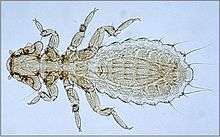chewing louse
English

A chewing louse (genus Menacanthus, unidentified species)
Noun
chewing louse (plural chewing lice)
- Any true louse that is not a sucking louse; a mallophagan.
- 1996, Gary A. Dunn, Insects of the Great Lakes Region, page 105:
- Many of the chewing lice are highly host specific, but a few may occur on a variety of not more than a half dozen related host species. They feed on skin (epidermal cells), hair, feathers, body oils and secretions, dried blood (wounds), and even other ectoparasites, such as mites. Chewing lice are unable to survive for more than a day or two off the host and their dispersal is through direct contact of host animals.
- 2003, William S. Romoser, Chapter 3: Introduction to ArthropodsSystematis, Behavior and Ecology, B.F. Eldridge, J.D. Edman (editors), Medical Entomology, page 60,
- There are cases where more than one species of chewing louse may infest the same host species and the lice may prefer living on specific parts of the host's body.
- 2013, Timothy M. Goater, Cameron P. Goater, Gerald W. Esch, Parasitism: The Diversity and Ecology of Animal Parasites, page 313,
- Lice have traditionally been divided into chewing lice (Mallophaga) and sucking lice (Anoplura) based on the structure of their mouthparts and the resulting feeding strategy.
-
Synonyms
- bird louse
- biting louse
See also
- Mallophaga (obsolete suborder)
This article is issued from
Wiktionary.
The text is licensed under Creative
Commons - Attribution - Sharealike.
Additional terms may apply for the media files.